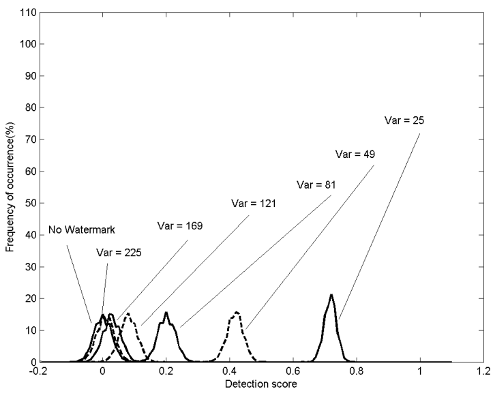Novel blind multiple watermarking technique for images
TLDR
Experimental results show that embedded watermarks using the proposed techniques can give good image quality and are robust in varying degree to JPEG compression, low-pass filtering, noise contamination, and print-and-scan.Abstract:
Three novel blind watermarking techniques are proposed to embed watermarks into digital images for different purposes. The watermarks are designed to be decoded or detected without the original images. The first one, called single watermark embedding (SWE), is used to embed a watermark bit sequence into digital images using two secret keys. The second technique, called multiple watermark embedding (MWE), extends SWE to embed multiple watermarks simultaneously in the same watermark space while minimizing the watermark (distortion) energy. The third technique, called iterative watermark embedding (IWE), embeds watermarks into JPEG-compressed images. The iterative approach of IWE can prevent the potential removal of a watermark in the JPEG recompression process. Experimental results show that embedded watermarks using the proposed techniques can give good image quality and are robust in varying degree to JPEG compression, low-pass filtering, noise contamination, and print-and-scan.read more
Figures

Fig. 30. (Left) MWE-watermarked image under LPF attack.PSNR = 31:82 dB. (Middle) Decoded watermark. (Right) Random watermark detection results. 
Fig. 26. Detection error of MWE under LPF attack. 
Fig. 6. (a) Original logo “UST”. (b)-(f) Original logo “Alphabet”. 
Fig. 23. Distribution ofS of MWE (IA-R, Q = 5) under JPEG attack. 
Fig. 28. Detection error of MWE under noise attack. 
Fig. 27. Distribution ofS of MWE under noise attack.
Citations
More filters
Proceedings Article
Digital color image watermarking by means of blind source separation
TL;DR: A novel strategic invisible approach for insertion-extraction of a digital watermark a color image, into color images by manipulating the least significant levels of the blue channel so as not to bring about a perceptible change in the marked image.
Dissertation
Efficient Algorithms for Embedding Digital Watermark in Curvelet Domain
TL;DR: In this article, the authors propose a method to solve the problem of the problem: this article..., and propose a solution.Xiv.xiv, p.
Proceedings ArticleDOI
Multipurpose logo embedding method for copyright protection and authentication
Yoon-Hee Choi,Tae-Sun Choi +1 more
TL;DR: A multipurpose logo embedding method by introducing the detection margin in the watermark detector that is more robust than previously proposed algorithms and can detect malicious manipulations.
Proceedings ArticleDOI
A New Algorithm of Compound Image Watermarking Based on DDWT
Huicheng Yang,Ting Zhang +1 more
TL;DR: A new compound image watermarking method is presented, which is embedding both robust watermark and fragile watermark to one image, so that it can not only convey the ownership, but also justify whether the source image is tampered.
Book ChapterDOI
Image watermarking algorithm based on the code division multiple access technique
TL;DR: In this paper, a multiple watermarking algorithm based on the CDMA spread spectrum technique is presented, where multiple copyright identifiers are convolutional encoded and block interleaved, and the orthogonal Gold sequences are used to spread spectrum of the copyright messages.
References
More filters
Journal ArticleDOI
Secure spread spectrum watermarking for multimedia
TL;DR: It is argued that insertion of a watermark under this regime makes the watermark robust to signal processing operations and common geometric transformations provided that the original image is available and that it can be successfully registered against the transformed watermarked image.
Book
Digital Watermarking
TL;DR: Digital Watermarking covers the crucial research findings in the field and explains the principles underlying digital watermarking technologies, describes the requirements that have given rise to them, and discusses the diverse ends to which these technologies are being applied.
Journal ArticleDOI
Hidden digital watermarks in images
Chiou-Ting Hsu,Ja-Ling Wu +1 more
TL;DR: The experimental results show that the proposed image authentication technique by embedding digital "watermarks" into images successfully survives image processing operations, image cropping, and the Joint Photographic Experts Group lossy compression.
Journal ArticleDOI
DCT-domain watermarking techniques for still images: detector performance analysis and a new structure
TL;DR: Analysis of a spread-spectrum-like discrete cosine transform (DCT) domain watermarking technique for copyright protection of still digital images is analyzed and analytical expressions for performance measures are derived and contrasted with experimental results.
Journal ArticleDOI
Rotation, scale, and translation resilient watermarking for images
TL;DR: It is shown that the watermark is robust to rotation, scale, and translation, and tests examining the watermarks resistance to cropping and JPEG compression.